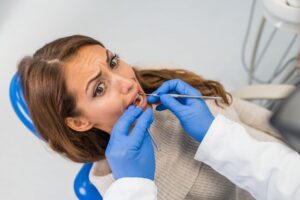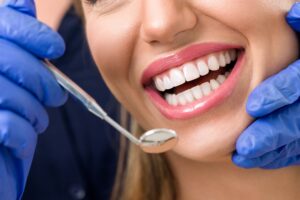Header logo
header top contact widget
Financing Options
Contour of Gum Tissues Is Important To A Smile’s Appearance
Posted on Oct 28, 2021 by William J. Claiborne, DDS MS
When people think of their smile, they tend to think primarily of their teeth. Certainly, having white, straight teeth are a major part of a smile’s appearance. In today’s cosmetic dentistry, porcelain veneers and crowns give an exceptionally natural appearance with excellent longevity and durability. However, the gum line that borders teeth can greatly affect a smile’s appearance, perhaps more than you’ve considered.
People with unflattering smile traits tend to “hold back” when smiling. They may smile with lips only or hold a hand in front of their mouths. Some men even admit to growing a mustache that extends down over the top lip to hide the teeth visible in a smile.
In addition to placing dental implants and treating all stages of gum disease, a Periodontist specializes in the treatment of the soft tissues of the mouth. As an expert in oral tissues, my advanced training enables me to contour gum tissues to provide a natural appearance and healthy seals around the base of teeth.
For several reasons, gum tissues can pull away from the base of teeth. This can occur from gum tissues becoming drier with age or over-zealous tooth brushing. Gums can also loosen their grip around teeth when teeth tilt out of their proper positions.
When the tight seal around the base of teeth is compromised, the tooth becomes more vulnerable to oral bacteria. Darker, sensitive tooth root segments may be exposed. This not only causes sensitivity, these areas become susceptible to bacterial penetration. As an entry point for oral bacteria, the tooth roots and bones that support teeth are more vulnerable to damage as well.
In cases when a tooth breaks near the gum line, a procedure known as crown lengthening may be able to expose enough of the tooth structure so a crown can be placed. This means the natural tooth can be saved rather than require removal. Once a natural tooth is removed, it brings with it a long list of decisions and associated costs.
Although protecting and saving teeth is the priority, gum contouring procedures, such as crown lengthening are also performed to enhance the appearance of a smile. Gum re-contouring is typically referred to as a “gingivectomy”. It is performed to remove the excess gum tissue that arches over the teeth most visible in a smile.
For example, for people who have a “gummy smile,” too much gum tissue is visible above upper teeth in a full smile. A periodontist can use his or her specialized skills to reshape the tissues to provide a more balanced smile line.
In this, crowns are typically placed in addition to having the gum height adjusted. The result? A smile is greatly improved when the gum line is contoured to blend attractively with gum tissue bordering neighboring teeth.
To begin, we numb the gum tissues and carefully trim the excess. As a Periodontist, I take specific measures to ensure a natural looking arch remains over the teeth while preserving the natural points that ‘dip’ between each tooth.
A gingivectomy performed with a dental laser provides our Asheville periodontal office patients with a number of advantages: (1) enhanced comfort; (2) precision lines; (3) minimal or no bleeding; and, (4) faster healing time.
It’s normal to experience some tenderness or swelling after the procedure. However, most patients do fine by applying an ice pack off and on for the first day. In most cases, over-the-counter pain medications are sufficient, however, we make prescription strength options available to ensure comfort during the healing process. Many patients tell us they needed no medication at all.
Healing time depends on each individual and can vary from a few days to a few weeks. The dental laser we use helps to reduce the amount of time needed for healing. For patients who smoke, healing times are longer due to smoking’s drying effect on gum tissues.
Most gingivectomies are followed by porcelain veneers or crowns to give a beautiful, even smile line.
For those who have avoided gum recontouring due to dental fear, we offer several sedation options, including oral and IV sedation. Oral sedation is a pill that helps patients relax. It also has an amnesiac effect, leaving most with little or no memory of treatment afterward.
IV sedation (also known as ‘twilight sleep’) places the patient in a deeper sleep state and erases memory of the procedure. It is administered by a doctor of anesthesiology for optimal comfort and safety. In our Asheville office, anesthesia is overseen by a medical doctor (MD) who is a board certified Anesthesiologist.
With both sedation options, patients are closely monitored with advanced safety equipment throughout treatment. We help patients understand that their fears and concerns are not unusual. Our doctors and staff respect each patient and provide gentle, compassionate care – at every appointment.
Treatment fees depend on the extent of the condition and whether crowns or veneers will be applied following treatment. In either case, beautiful results can occur, helping the individual who once ‘held back’ on smiling confidently.
A healthy smile is a benefit to our overall health. An attractive, confident smile is also an asset when it comes to self-image, helping us to feel good from the inside out! Call 828-274-9440 for a consultation to discuss a gingivectomy and what may be recommended for your specific needs.
What’s Keeping You From The Dentist’s Office?
Posted on Oct 19, 2021 by William J. Claiborne, DDS MS
As an Periodontist in Asheville NC, I’ve treated many patients who, to no surprise, developed periodontal (gum) disease because of NOT going to a dentist on a regular basis.
According to the Centers for Disease Control & Prevention (CDC), nearly 65 percent of adults aged 18 and over had at least one dental visit in the past year (based on 2019).
https://www.cdc.gov/nchs/fastats/dental.htm
Unfortunately, that leaves 35 percent of adults who did not. 
The reason it is recommended to see a dentist for exams and cleanings TWICE A YEAR is because tartar, which is hardened plaque, can cause cavities and gum disease. One plaque hardens into tartar, it can no longer be brushed or flossed away. It must be removed by a dentist or hygienist using special tools.
Tartar is actually a mass of oral bacteria, which has attached itself to the base of (or in-between) teeth. Tartar (also referred to as calculus), is a colony of bacteria that thrive on oral tissues. Bacteria are living organisms and reproduce rapidly. And, the more there are, the more rapidly they amass.
So, what are the common excuses for avoiding regular dental care? See if you’ve been guilty of one or more:
COST – Some individuals feel dental cleanings and exams are expensive. Actually, there is a great deal of time and training that goes into your individualized care. In addition to the measures of sterilization and instruments, hygienists and dentists are highly-trained, educated, and must stay board certified. As for the investment, these visits are what help you avoid the need for a filling, gum disease, potential damage to teeth due to bite misalignment, and even catch oral cancer at early stages. If dental insurance is not possible, ask if payment plans are available. Many dental offices offer these, most of which are interest-free with no down payment required.
DENTAL FEAR – If fear or anxiety keeps you away from a dental chair, you are not alone. It is estimated that over 70 percent of American adults have some level of this. Sometimes the fear exists because of a traumatic experience in the past or feeling helpless in the chair. Some people react to certain smells and sounds. A few have no idea what prompted their fear, but know it is beyond their control. For these, we advise seeking dental care in a modernized office. Today’s advanced technology has greatly enhanced the level of comfort during care as well as reduced treatment time. Too, offices such as our Asheville periodontal dental office offer oral sedation as well as IV sedation (twilight sleep). These are administered by highly-skilled professionals who oversee the patient using advanced safety monitoring equipment. Ask for a consultation and tour before choosing the office that is reassuring to your unique needs.
DREAD OF BEING LECTURED – If it’s been years since you’ve seen a dentist, you may be expecting a lecture from the dentist or hygienist (or both!). My staff and I believe that is a sure way to deter someone from cultivating a positive attitude towards their dental relationship. We all want to feel respected and having a caregiver talk “down” to you is unfair, especially because no one knows the story behind your delay or avoidance. If you feel that’s going to be a problem, say so. Be upfront with “a lecture is not going to help me.” If you feel it’s a recurring problem, ask to have your records transferred to an office where you are treated more appropriately.
FEAR OF EMBARRASSMENT – Some adults feel awkward having their denture or partial removed at the dentist’s office. Some people fear they’ll gag during care, which can trigger coughing and even throwing up. Some feel their mouths are so “bombed out” that it’s embarrassing to have a dentist see how much damage has occurred. To reassure you, there is nothing we haven’t seen or experienced. Dentists have quite a lot thrown at us during dental school. As a specialist in periodontics, my additional training covered even more in-depth and complex damage or disease. DO NOT worry about your caregivers. They WANT you to rely on them to help you. Almost any dentist or specialist will tell you that our greatest joy comes from taking a patient from a “hopeless” mouth to a patient who has a healthy, confident smile!
TIME IN TREATMENT – Today’s advanced technology has greatly condensed the time needed to accurately diagnose and treatment plan almost any dental problem. Many treatments can be completed in just one or two visits. For those who have more extensive needs, dentists can sometimes combine several appointments into one long one. This is made much easier for the patient with the addition of oral sedation. Oral sedation creates a totally relaxed state so the patient can “doze” in and out of treatment. It has a quick recovery and sedated patients are carefully monitored for safety and comfort throughout treatment.
Regardless of WHY you’ve avoided the dentist, your smile is worth it! Having an appealing smile you feel joyful in sharing adds to your mood, enhances appearance and makes a positive impression to others.
If you’ve avoided dental care for years (or even decades), you may have signs or symptoms of periodontal disease. These include tender gums that may bleed when brushing, gums that recede from the base of some teeth, gums that turn red in color, and frequent bad breath. Gums are the foundation for teeth, so without healthy gums, your teeth will not be healthy, either.
Too, gum disease will only worsen without treatment. If you are a reader of my articles, you may have read the findings of research that correlates the bacteria of gum disease with serious health conditions. These include stroke, heart disease, preterm babies, some cancers, arthritis, diabetes, and erectile dysfunction.
Let us help you feel the positive aspects of achieving a healthy smile. Begin with a consultation by calling 828-274-9440.
Postponing Dental Care Can Be Expensive
Posted on Sep 29, 2021 by William J. Claiborne, DDS MS
Most of us have seen the movie, “Gone With The Wind,” It’s pretty hard to forget the last line of Scarlet O’Hara: “I’ll think about that tomorrow.”
Procrastination is something we all do, some more than others. We all tend to “back burner” things we don’t want to do. As a periodontal dental specialist, I’m guilty of this on occasion.
However, I see a number of patients who have developed periodontal (gum) disease because they delayed or postponed dental care; care that would have easily helped them avoid the problems associated with it.
The reason 6-month dental check-ups are so beneficial is in their ability to give patients a twice-a-year clean slate in oral wellness. During this time, the dentist and hygienist can examine the mouth for signs of abnormal wear, bite alignment, and point out areas that need extra attention in oral hygiene routines at home. (This is especially true for people who have crowded or crooked teeth, as bacteria can easily accumulate in these tight angles.)
This dental appointment also allows the hygienist to remove plaque or tartar that has formed since the patient’s last check-up. Both are accumulations of oral bacteria, which will continue to reproduce rapidly without regular removal.
Plaque starts the process. It is the sticky film you probably feel on teeth when you first wake up. This film is actually a layer of bacteria that has rapidly reproduced during the night. (If you snore or breathe through your mouth during sleep, oral dryness can accelerate the rate of reproduction even more.)
Although it is more obvious on teeth, the film of plaque also coats the gum tissues and tongue. If not thoroughly removed within 48 hours, these bacteria amass to such a level that the plaque hardens. This is known as tartar.
Tartar typically forms between teeth and at the base of teeth. This is why daily flossing is helpful. It scrapes off plaque in areas the toothbrush may not reach, or may not be cleaning sufficiently.
Once tartar forms, however, it can no longer be removed by brushing and flossing. This is what the hygienist is picking at and scraping off teeth during dental cleanings. If not removed, these bacterial colonies continue to grow. And bacteria breed at an amazingly fast pace.
Just how quickly can these oral bacteria amass?
According to information shared by RDH Magazine: (https://www.rdhmag.com/infection-control/water-safety/article/16404976/oral-bacteria-how-many-how-fast)
“some species of oral bacteria can double their numbers every 20 minutes under ideal conditions in a Petri dish.”
This means that one million bacteria can grow to 14 million within an hour. Accumulated bacteria can even be seen in the mouth as a white coating on the tongue. The back of the tongue is typically whiter in color since tooth brushing doesn’t reach there and dislodge embedded bacteria. (This is why it’s important to brush your tongue every day when toothbrushing, or use a tongue scraper.)
Tartar holds such a high number of bacteria that these organisms can cause damage to teeth. They bore into tooth enamel and eat away at oral tissues.
Bacteria are ramped up by foods we eat. They especially love lingering food particles caught between teeth and foods containing sugar. (This is yet another reason to floss daily.)
Initially, gum disease causes tender gums that may be swollen. They may bleed when brushing, which is typically noticed when spitting. Symptoms may also include frequent bad breath, gums that are more red in color than a healthy pink, and soreness when brushing or flossing.
Keep in mind, this is just the beginning. This stage is known as Gingivitis and is just a prelude of what’s to come. If prompt measures are taken as soon as these symptoms arise, Gingivitis may be overcome without requiring dental treatment. Thorough brushing (twice a day, at least), daily flossing, and keeping the mouth moist with plain water may be effective in overcoming Gingivitis.
If not resolved, Gingivitis can progress to periodontal disease. During this level of gum disease, breath odor is persistently bad. The gums bleed easily when brushing and are more red in color. Gums are sore and tender. As the disease worsens, the gums become spongy and pus pockets may form at the base of teeth.
Eventually, the bone tissues and gums become so damaged by periodontal bacteria that some teeth may loosen. This stage is periodontitis and is an infectious disease that can cause devastation far beyond the mouth.
Periodontal disease is the nation’s number one cause of adult tooth loss.
These potent bacteria can enter the bloodstream, creating inflammatory reactions that can activate or worsen a number of serious health problems. These include heart disease, stroke, high blood pressure, diabetes, arthritis, preterm babies, some cancers, impotency, erectile dysfunction, and Alzheimer’s disease.
That’s a pretty serious list. As research continues to study the far-reaching effects of these infectious bacteria, the list seems to lengthen more.
Have you been putting off dental care? Treating advanced gum disease and replacing teeth are both pretty involved procedures.
In many cases, I’ve found patients avoid or delay dental care due to feeling it is too expensive or having fear associated with dental visits. Yet, the price (in time and money) from not properly caring for oral health is steep in many ways.
The devastation caused by these bacteria can be easily avoided with simple measures at home and 6-month dental visits. An at-home dental care regimen should only require about 5 minutes per day. A dental check-up usually takes about an hour.
If you are very uncomfortable during dental cleanings, tell your hygienist. He or she may be able to provide a pre-treatment rinse or a topical swab for more sensitive areas. (Just know that until your gums get into healthier shape, it is the inflammation caused by oral bacteria that makes them more sensitive.)
The obstacles that typically prevent patients from receiving the care they need are:
Cost: Most dental practices offer payment plans that are interest-free with no down payment required. If you don’t have dental insurance, ask about any discounts they may offer or consider using a credit card.
Dental fear: In our Asheville periodontal dental office, we offer both oral and I.V. sedation (“twilight sleep”), if desired. We understand that many adults have anxiety or fear when it comes to dental treatment. Our entire staff is committed to providing all patients with a gentle touch, a respectful environment, and compassionate care.
Embarrassment or feeling a smile is “hopeless”: We see many adults who have “bombed out” mouths. This can happen for a number of reasons. Here, we are a “judgement-free” perio office and treat every patient as we would want our loved ones treated. And, no smile is hopeless. We have a great many patients who are testaments to that!

For patients who have lost natural teeth, for whatever reason, a periodontist has advanced skills in the diagnosis and placement of dental implants. Once your gums are restored to a healthy state, we can discuss that tooth replacement option, if you like.
As with most things in life, delaying care is a sure recipe to get deeper in the problem. Be committed to your daily oral care routine and keeping regular dental appointments. If you are having symptoms associated with any stage of gum disease, however, I am a dental specialist in treating even advanced levels.
Call 828-274-9440. A referral is not needed.
Why You’re Losing Teeth (and how to halt the process)
Posted on Jul 29, 2021 by William J. Claiborne, DDS MS
The inevitable. Murphy’s law. Sooner or later.
It is to no surprise that life throws us occasional curves, some being out of the blue and others being somewhat predictable. As an Asheville Periodontal Specialist, one that comes to mind is the path to losing teeth.
Losing natural teeth is a challenge to both oral and overall health. And, there’s nothing that will definitively replace natural teeth once they’re extracted (although dental implants come pretty close!). Keeping natural teeth and gums healthy is the best way to support your health as you age.
According to a 2017 article published by Dentistry Today that shared recent study findings:
“people who had lost 5 or more teeth by the age of 65 years were more likely to suffer from cardiovascular disease, diabetes, and osteoporosis, all of which could severely limit life expectancy. Many of these illnesses previously have been linked to a person’s quality of life and socioeconomic status. The study concludes that the number of teeth in aging humans can affect longevity and life expectancy.”
https://www.dentistrytoday.com/news/industrynews/item/1632-life-expectancy-linked-to-number-of-teeth
Of course, no one wants to lose a natural tooth. Yet, many people assume that tooth loss is simply a natural part of the aging process. It’s not.
Through the years, certainly, accidents, injuries, decay, gum disease and deep fractures in teeth can result in loss of teeth. Regardless of how committed some people are to their oral hygiene regimen at home and regular dental check-ups, unexpected occurrences can lead to the need for an extraction.
However, the people who are committed to their oral health are far less likely to endure the undesirable outcome of tooth removal. The measures are simple and take very little time.
• Brush your teeth at least twice a day, for a minimum of two minutes each time.
• Floss daily.
• Avoid snacking and limit sugar.
• Drink plenty of water.
• See your dentist twice a year for exams and cleanings.
• Don’t smoke.
Although smoking cessation is a tough task for most people, the other items listed above require just minutes a day and cost very little. What they help you accomplish is PREVENTION. Rather than have problems treated, many instances surrounding tooth loss could have been prevented.
It is far less costly and time consuming to be attentive to your oral health than deal with the repercussions of insufficient oral upkeep. Losing a tooth will require a lifelong commitment, regardless of how it is replaced. And, replacing teeth is absolutely necessary.
When a tooth is lost, whether it can be seen in a smile or not, it no longer supports the surrounding teeth. The tooth above (or below) can elongate. Neighboring teeth can tilt or turn since they lack the bolstering affect provided by the now-missing tooth.
These factors can lead to chipped, fractured or broken teeth. They can also be an issue in bite misalignment. A misaligned bite can cause stress or strain on the temporomandibular joints (TMJ). The results can be frequent headaches, sore jaw joints, ear ringing, dizziness, and difficulty opening the mouth fully.
Another problem lies in the absence of the missing tooth’s roots. When these roots are missing, there is a lack of stimulation and nourishment to the jaw bone in this area. Without this, the bone begins to shrink, or resorb. Bone mass decline affects the stability of the adjacent teeth. It is known that the next tooth to be lost will most likely be one bordering a missing one.
The path to tooth loss, other than accident or injury, is actually a pretty predictable one. For people who take their oral hygiene lightly, it’s not a matter of “if” but “when”. Bacteria buildup in the mouth should be removed regularly, which is why twice-daily brushing is advised. If not thoroughly removed, their growth runs rampant.
Saliva flow helps in moving some bacteria out of the oral cavity. However, as people age, saliva flow decreases. Add to that the many elements that are drying to oral tissues: caffeine (including coffee, tea and colas), many medications, snoring, and some health conditions.
Oral bacteria that accumulate in the mouth for more than 48 hours first create a sticky film that coats the teeth and gums. This is plaque. If not removed through brushing and flossing, plaque transforms into hardened masses on the base of (or between) some teeth. This is tartar, which can no longer be brushed or flossed away.
As tartar spreads, the gums become inflamed. This causes gingivitis – the first stage of gum disease. Gingivitis causes the gums to become tender, swell, and sometimes bleed when brushing. Breath odor can become frequently bad.
If not resolved quickly, gingivitis can progress into full-blown gum disease. At this stage, the gums are red, inflamed, tender, bleed easily and breath odor is bad, even shortly after brushing.
As gum disease worsens, gums loosen their strong seal around the base of teeth. This allows entry of these infectious bacteria below the gum line. The structures that support natural teeth (including bone) are attacked, which can cause some teeth to loosen.
The advanced stage of gum disease is periodontitis. This means that gum tissues are red, spongy, have pockets of pus, bleed even when eating, and breath odor is putrid. To add insult to injury, this devastation doesn’t remain only in the mouth. Through tears in diseased gum tissues, the inflammatory bacteria of gum disease can enter the bloodstream.
This bacteria has been linked to serious, even life-threatening, health problems, as severe as stroke, heart disease, some cancers and Alzheimer’s disease. It can cause inflammatory triggers that worsen diabetes and prostatitis and cause preterm births.
Obviously, it’s important to keep your teeth and gums healthy. And, if tooth loss does occur, consider replacing it/them with dental implants. As an Asheville periodontist, one of my areas of advanced skill is in dental implant diagnosis and placement.
Dental implants are the closest thing to the look, feel and function of natural teeth. They restore dependable biting and chewing, without the need to be removed for cleaning. Best of all, confidence in smiling and laughing returns.
We frequently see Western NC adults who feared they would lose teeth due to periodontal disease and/or had already lost one or more natural teeth. Through our advanced skills and computerized technology, we are often able to fully restore people to excellent oral health and halt the progression of tooth loss.
If you have avoided seeing a dentist because of fear or anxiety, please know that we provide our patients with an environment of respect and comfort. We offer I.V. sedation (‘twilight sleep’) as well as oral sedation to create a totally relaxed state throughout treatment.
If cost is a concern, we also have payment plans that can help you achieve the smile you desire while making monthly payments that fit your budget.
Why allow tooth loss to happen? It CAN and SHOULD be prevented and we can help you regardless of your current oral condition. Call 828-274-9440 to request a consultation appointment. This will take place in a private consultation room where your questions will be answered thoroughly.
Recent Posts
Categories
Archives
- September 2024
- August 2024
- July 2024
- June 2024
- May 2024
- April 2024
- March 2024
- February 2024
- January 2024
- December 2023
- November 2023
- October 2023
- September 2023
- August 2023
- July 2023
- June 2023
- May 2023
- April 2023
- March 2023
- February 2023
- January 2023
- December 2022
- November 2022
- October 2022
- September 2022
- August 2022
- July 2022
- June 2022
- May 2022
- April 2022
- March 2022
- February 2022
- January 2022
- December 2021
- November 2021
- October 2021
- September 2021
- August 2021
- July 2021
- June 2021
- May 2021
- April 2021
- March 2021
- February 2021
- January 2021
- December 2020
- November 2020
- October 2020
- September 2020
- August 2020
- July 2020
- June 2020
- May 2020
- April 2020
- March 2020
- February 2020
- January 2020
- December 2019
- November 2019
- October 2019
- September 2019
- August 2019
- July 2019
- June 2019
- May 2019
- April 2019
- March 2019
- February 2019
- January 2019
- December 2018
- November 2018
- October 2018
- September 2018
- August 2018
- July 2018
- June 2018
- May 2018
- April 2018
- March 2018
- February 2018
- January 2018
- December 2017
- November 2017
- October 2017
- September 2017
- August 2017
- July 2017
- June 2017
- May 2017
- April 2017
- March 2017
- February 2017
- January 2017
- December 2016
- November 2016
- October 2016
- September 2016
- August 2016
- July 2016
- June 2016
- May 2016
- April 2016
- March 2016
- February 2016
- January 2016
- December 2015
- November 2015
- October 2015
- September 2015
- August 2015
- July 2015
- June 2015
- May 2015
- April 2015
- March 2015
- February 2015
- January 2015
- December 2014
- November 2014
- October 2014
- September 2014
- August 2014
- July 2014
- June 2014
- May 2014
- April 2014
- March 2014
- February 2014
- January 2014
- December 2013
- November 2013
- October 2013
- September 2013
- August 2013
- July 2013
- June 2013
- May 2013
- April 2013
- March 2013
- February 2013
- January 2013
- December 2012
- November 2012
- October 2012
- September 2012
- August 2012
- July 2012
- June 2012


